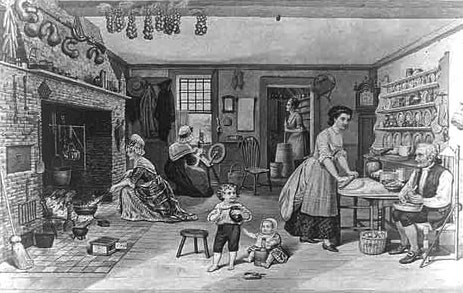Her days were long: Late at night, after she finished tending the family farmstead, drying apples, making wine, and preparing and cooking food, there was still more work to be done — the cleaning, the washing, the mending, the ironing, all of it endless. But Mary Cooper, a Colonial era wife and mother, sought solace from the never-ending chores by recording observations about her life on the Cooper farmstead, 3 miles from Oyster Bay, where she lived with her husband and their six children.
She made her first diary entry at age 54, in 1768. She was not well educated, often misspelling words as she wrote, but she put it all down on paper, from describing the environment and the weather — “The bay tide was high. There was a great snowstorm” — to providing for the travelers she gave meals and lodging to — “They did nothing but drink themselves drunk all the day long and sent for more rum…. I greately dread the cleaning of … hous after this detested gang,” and how it affected her: “O, I am tired almost to death waiteing on visseters. My feet ach as if the bones was laid bare…. I have no time to take care of my cloths or even to think my thoughts.”
WHAT HER WORDS REVEAL
So what do we know about this wife and mother who took to writing regular notes in her journal for 10 years, by candlelight or oil lamps, just before going to bed? Her unabridged, hand-sewn Diary of Mary Cooper: Life on a Long Island Farm, 1768-1773, handwritten in cursive, has survived through the centuries to provide us today with a close look at life during the early settlement years. As The New York Times observed, her diary “records the daily events of her life — its joys, its sorrows, its drudgery, its pathos, its loneliness and its isolation.”
Mary Wright was born on May 14, 1714, in Oyster Bay Town, which was then part of Queens in the New York Colony in British Colonial America. When she was 14 or 15, she was married to Joseph Cooper, who was 23, in St. George’s Chapel in Hempstead, Long Island, on May 22, 1729. She gave birth to her first child at 18; all six of her children died, many as infants, during her lifetime.
HARD LABOR AND SORROW
She struggled to get through the hardships by recording the family’s living conditions, noting that “There was little fire inside to heat the room,” and by revealing her moods: “The early songsters warbling their notes and all nature seemes to smile, but a darke cloud hangs continuly over my soul and makes the days and nights pass heavily along.”
At a time when smallpox inoculation was just beginning to be accepted, disease in the colonies took many lives. Three of her siblings died young, and seeing all her own children die left her with “sorrow and loss unspakabel.” Many of her notations speak of sadness and how tired she often was. She wrote of having a “heavy hearte,” but her outlook was sometimes lightened by her deep religious faith, sustained after she walked or traveled by boat to New Light Covenant Church “meetens:” She observed that “My greatest vews seeme to be of my Jesus seated on a throne of glory in the bright relms of etarnel day. The pleaseing luster of his eyes out shine the wonders of the skys.”
She summed up her days of constant work, writing, “It has beene a tiresom day to me. It is now bed time and I have not had won minuts rest today.” The dark sadness that plagued her left her “very much distrest.” It is impossible to know if that sadness evolved from depression, from being excessively fatigued from the workload, as when she reveals that “We seeme to have little or no sence of any thing but our troubels” and “here have I seene littel els but harde labour and sorrow, crosses of every kind,” or from the many losses she endured. Another pressure faced by the Coopers came from people to whom they owed money, who harassed the family. She wrote of the debtor pressure: My hearte is burnt with anger and discontent, want of every nessesary thing in life and in constant feare of gapeing credtors consums my strenth and wasts my days.”
Although she continued to write in her diary until she died at age 64 in 1778, the last surviving entry was Oct. 8, 1773; subsequent entries have been lost. She is buried at Baptist Church Cemetery in Oyster Bay.



































